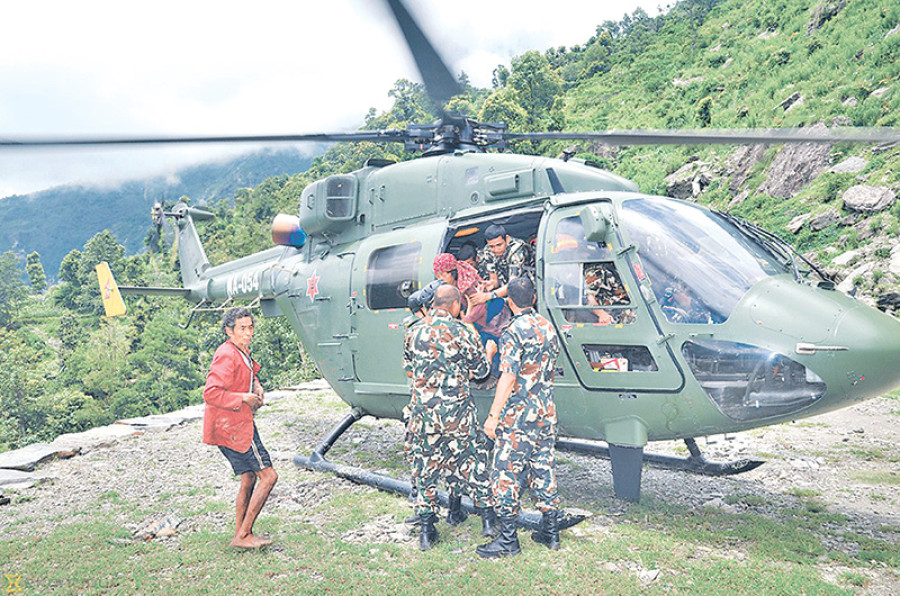Opinion
Local units to the rescue
Depending overly on the security forces for disaster management is not a good idea
Shrijan Bahadur Malla
It’s normal for people to forget their pain and anguish with the passage of time. Three years ago, a 7.8 magnitude earthquake shook Nepal, taking the lives of nearly 9,000 people and pushing 1 million people below the poverty line just as the country was beginning to recover from the devastation of a decade-long Maoist conflict. The earthquake was one of the deadliest natural disasters in Nepal’s history.
The country hasn’t been able to do much to heal the suffering of the victims of this disaster in the last three years because the reconstruction and rehabilitation process has been moving extremely slowly. One achievement was the promulgation of the Disaster Risk Reduction and Management Act 2017. It replaced the Natural Calamity Relief Act 1982. The old Act focused more on relief and rescue efforts, while the new piece of legislation covers a broader spectrum ranging from disaster management, hazard mitigation, risk management and response to recovery and rehabilitation.
Whether this act can be implemented effectively at the ground level when the state is struggling with political, economic and social challenges remains a critical question. At the local level, lack of interest in disaster preparedness and the absence of seriousness in taking ownership are the greatest problems. Although communities are suffering greatly from recurring disasters every year, very few mitigation activities have been conducted.
Focus on local involvement
Similarly, lethargy prevails in the system due to the lack of an autonomous authority. At the district level, disaster management is an ad hoc responsibility given to the overworked District Administration Office. An independent mechanism to deal with disaster management 24/7 is needed.
The Disaster Risk Reduction and Management Act 2017 is comprehensive. It has made the provincial and local levels accountable and given them adequate authority. They are responsible for formulating their own policies and action plans, establishing an early warning system, devising a coordination mechanism, managing warehouses and resources, creating a pool of volunteers and training and mobilising them, and running awareness programmes.
Unfortunately, many local bodies don’t know what they are supposed to do. Many of them have not even established a local disaster response committee. Likewise, they don’t know that they have to make a separate budget allocation for disaster management, and that 70 percent of the funding should be set aside for mitigation and 30 percent for relief and response.
In Nepal, the security forces have been at the forefront of disaster response and recovery. In the absence of an effective civil defence mechanism for disaster response, the security forces are the key responders. For a poor country like Nepal the rational for this approach is that the government doesn’t have to commit extra resources to establish a separate search and rescue mechanism. This frees resources to be used somewhere else for development work.
Over-reliance an issue
Some scholars call this ‘over-reliance’ on the security forces a ‘repercussive approach’. One, depending excessively on the army and police generates lethargy in the civilian authorities, and dissuades them from creating an effective civilian disaster response mechanism. Two, this gives an opportunity to the security forces to put their feet in the political arena which will be counterproductive for the country and the organisation.
Moreover, if a natural disaster should strike when an armed conflict is on-going, use of the security forces in relief and response operations will raise questions regarding neutrality and impartiality as the forces will likely be party to the conflict as well. In such a situation, international humanitarian organisations will hesitate to offer assistance. In Nepal, where illiteracy, poverty, lack of development and political instability are prevalent, there will always be a possibility of a return to conflict.
Although strengthening ownership of local communities is a must to establish community-based disaster response mechanisms, how to make them aware and responsive is the crux of the problem. There is an immediate need for local governments to bring risk management programmes with the maximum participation of vulnerable communities. Their involvement in identifying hazards, devising local strategies and developing activities will help to give ownership to the venture. Similarly, inclusion of disaster risk reduction education in the school and college curriculums will also help to generate awareness in the long run.
Second, although there is a plethora of organisations like government agencies, NGOs, INGOs and public and private sector organisations engaged in disaster management, their activities are hardly synchronised. Hence, provincial and local governments should establish a coordination mechanism to ensure synergic efforts. This will help to avoid duplication of effort and save time and resources during emergencies. Third, generating awareness and enhancing the capacity of the local staff and elected representatives is a must. Lastly, the tendency of over-reliance on the security forces can be reduced by developing the local response capacity. Local governments should establish fire brigades, search and rescue groups and medical teams.
Malla is pursuing a PhD in disaster management from Kagawa University, Japan




 16.12°C Kathmandu
16.12°C Kathmandu










